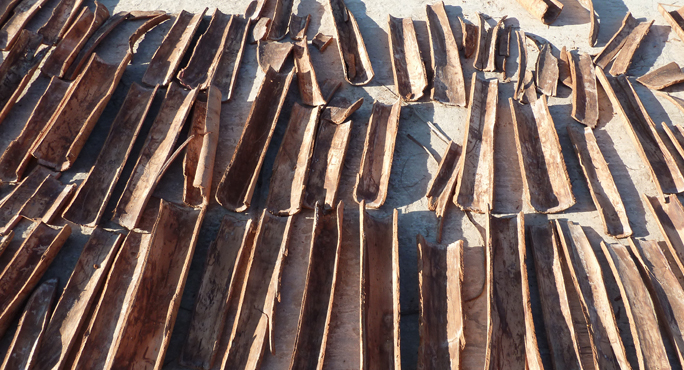
Chuchuhuasi in Peruvian Market. Photo by Chris Kilham
The great Amazon rainforest is both the most bio-diverse place on Earth, and the largest natural pharmacy. Many hundreds of Amazonian native remedies have been well documented and studied.
Among them, one of the very most popular is chuchuhuasi (Maytenus krukovii), a very large canopy tree, whose bark has been used as a general remedy for many centuries. Shamans, medicine men and women commonly employ chuchuhuasi for both curative and prophylactic purposes.
Chuchuhuasi is highly popular throughout the Peruvian Amazon especially. Sections of bark are commonly sold in herbal markets, and many fluid preparations of chuchuhuasi can be found. Chuchuhuasi liquors, from wines to distilled alcohols, show up in grocery stores and airport gift shops. To say that chuchuhuasi is everywhere in the Peruvian Amazon is not much of an exaggeration.
Traditionally chuchuhuasi is used to relieve pain and inflammation, to treat arthritis, rheumatism and back pain, to restore vigor after a debilitating disease, as a general tonic, and for relieving menstrual pain and enhancing libido. Chuchuhuasi is pretty close to an all-in-one remedy. It is consumed by itself or with other herbs, and can be prepared by simply soaking some bark in a glass of water overnight, or by putting bark and cane alcohol (aguardiente) into a vessel and letting the alcohol extract the beneficial compounds from the bark.
Chuchuhuasi contains a variety of naturally-occurring compounds, notably the two tumor-fighting alkaloids mayteine and maytansine. The bark is rich in several alkaloids, tannins, triterpenes and sesquiterpenes. The pyridine alkaloids in the bark may be primarily responsible for its anti-arthritic effects. The anti-tumor agents tingenone and pristimeran may account for use of the bark to treat certain cancers, notably those of the skin. The protein kinase C (PKC)-inhibiting agents in chuchuhuasi have been studied by Sphinx Phatmaceuticals of Durham, NC. PKC is implicated in many chronic degenerative disorders, including cancer, cardiovascular disease, and arthritis. An effective PKC-inhibitor could potentially save lives. Without question, chuchuhuasi bark contains a concentration of powerful protective agents.
In my own travels in the Peruvian Amazon, I have come upon chuchuhuasi all over the place. Harvesting the bark provides supplementary income for native people who cobble together a living by growing, collecting or catching various crops and fish. Along the Ucayali River in Peru I have hiked into the forest with Shipibo natives who stopped at large chuchuhuasi trees to cut bark. In the Contamana region, I have seen large bundles of dried chuchuhuasi bark stacked and ready for market. And at various herbal stalls, from the chaos of Lima’s La Parada market to the spooky atmosphere of Witch’es Alley in the Belen Market in Iquitos, I have seen countless fluid preparations of chuchuhuasi, as a stand-alone remedy and with other pain-relieving or energy-enhancing herbs. At home I keep a large container of chuchuhuasi and cat’s claw handy, for general tonic and pain-relieving purposes.
Little known in the U.S. at this point in time, chuchuhuasi has a steep curve to travel before it is widely used among the general public. But the good news is that when you try it, you will like it. Chuchuhuasi is an experiential herb. When you take a preparation of the bark, you feel it. The feeling is good. It makes you feel stronger, more alive. Just as unknown herbs with strange names have eventually become known and popularly employed, I believe that same can and will happen with chuchuhuasi. It’s just a matter of time.
We like Chuchuhuasi Tea-Cut Raw Wildcrafted, by Sunfood Superfoods.

